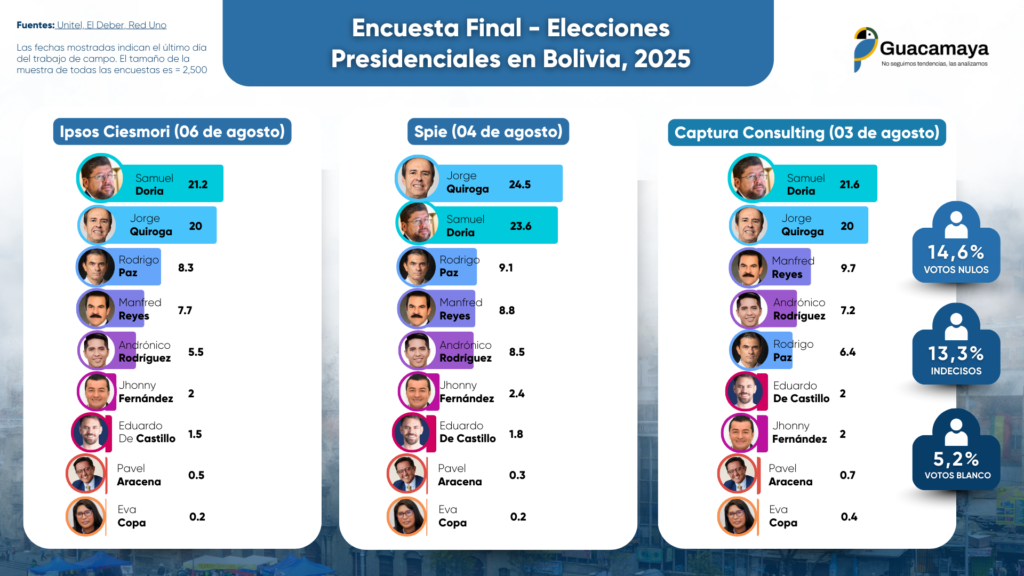Evo Morales, Bolivia’s president from 2006 to 2019, is now urging null votes against both the right and his former party, MAS. Photo: Samuel Auguste.
Jorge Barragán is an international analyst and a graduate of the Central University of Venezuela.
Guacamaya, August 14, 2025. Bolivia is gearing up for elections this Sunday, August 17, with the latest polls giving a 99% chance of a runoff on October 19. The situation is clear: no candidate is anticipated to secure the 50% of votes necessary to win outright in the first round.
The main competition is between former President Jorge “Tuto” Quiroga and businessman Samuel Doria Medina. For the first time, some polls indicate Quiroga could potentially win, yet Medina is still favored to lead in the initial round.
The context is unlike anything before: Bolivia’s left is disjointed and lacks a strong candidate after President Luis Arce chose not to seek reelection and former President Evo Morales was legally prevented from running. The rift between these leaders has weakened the Movement for Socialism (MAS), which ruled the country for nearly two decades.
A Country Under Economic and Social Pressure
The campaign is unfolding amidst record inflation—nearly 25% year-over-year, based on official data—and shortages of dollars and fuel that have ignited protests and social unrest.
This crisis is exacerbated by falling lithium exports, diminishing fiscal revenues, and internal political disagreements. Morales, barred from participating and in conflict with the current administration, has called for null votes, further undermining his political faction. Candidates like Andrónico Rodríguez—once seen by Morales as his successor but now labeled a traitor—and ex-minister Eduardo del Castillo, who is supported by Arce, are contending with a disillusioned and fragmented electorate.
The End of a Strategic Alliance with Venezuela
Historically, Bolivia has been among Venezuela’s most steadfast allies in South America. From the close ties between Evo Morales and Hugo Chávez to ongoing connections with Nicolás Maduro, La Paz has maintained comprehensive commercial, diplomatic, and political partnerships.
At present, both nations share an annual trade exchange of nearly $9 million and a direct flight linking La Paz and Caracas. In various international settings, Bolivia has consistently backed the Venezuelan government’s positions. However, all indications point to a shift in the ideological direction of Bolivia’s next government, likely ending this long-standing alliance.

Quiroga vs. Doria Medina: The New Political Axis
The main contenders, who started the campaign as companions, now embody opposing political visions—but with a shared aim: both seek a shift towards the center-right, moving away from MAS’s ideological stance.
Samuel Doria Medina
Profile: A businessman and social democrat, he served as Planning Minister (1991–1993) under Jaime Paz Zamora’s administration. He was a key player in the 1990s privatization movement.Economic proposal: Fiscal cuts, privatization of state-owned enterprises, and enticing foreign investment, particularly in gas with Brazil and Petrobras.Foreign policy: Reestablish relations with the U.S., strengthen partnerships with Europe, and keep ties with Russia and China. He aims to suspend interactions with Cuba and Venezuela “until democracy returns” and pull Bolivia out of ALBA while retaining involvement in BRICS.
Doria positions himself as a businessman outsider, but this marks his fifth attempt for the presidency. He currently holds the role of Vice President for Latin America and the Caribbean of the Socialist International.
Jorge “Tuto” Quiroga
Profile: A conservative politician who briefly served as Bolivia’s president (2001–2002).Economic proposal: Economic restructuring with IMF support and traditional stabilization measures.Foreign policy: Complete alignment with the U.S., withdrawal from Mercosur, and severing ties with Iran. He has consistently criticized Chavismo and the PSUV in international forums like the IDEA Group.
After three unsuccessful presidential campaigns, Quiroga is aiming to reclaim the top position in the Palacio Quemado. The candidate of the Liberty and Democracy alliance (running under the name Libre), he has opposed MAS for nearly 20 years.
The Weight of Santa Cruz and the Rural Vote Wildcard
The Santa Cruz region, home to 22% undecided voters and the largest population in the country, holds the potential to determine not only the first-round winner but also who holds an advantage going into a potential runoff.
The rural vote—comprising about 30% of the electorate and traditionally a MAS stronghold—could yield surprises. It’s the last chance leftist candidate Andrónico Rodríguez hopes will drive him to a runoff, though this seems unlikely considering his declining poll standings and Morales’ recent public criticisms.
The Surprise Factor: Rodrigo Paz
A notable name is Rodrigo Paz, the candidate from the Christian Democratic Party and son of former President Jaime Paz Zamora. Running alongside Edman Lara, a former National Police captain with corruption allegations, Paz has gained popularity on social media, especially TikTok. Polls unexpectedly place him in third, possibly capturing enough votes to become a significant player in a runoff.
An Ideological Shift with Regional Repercussions
If a runoff materializes and one of the two main candidates prevails, Bolivia will align with center-right governments in the region, marking a break from over 17 years of MAS dominance (with the exception of Jeanine Áñez’s interim government).
This transformation would directly influence South American geopolitics, relations with Venezuela, and Bolivia’s position within blocs like ALBA, Mercosur, and BRICS.